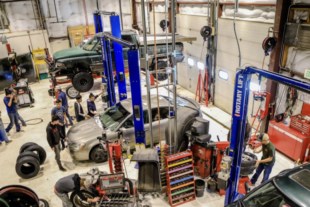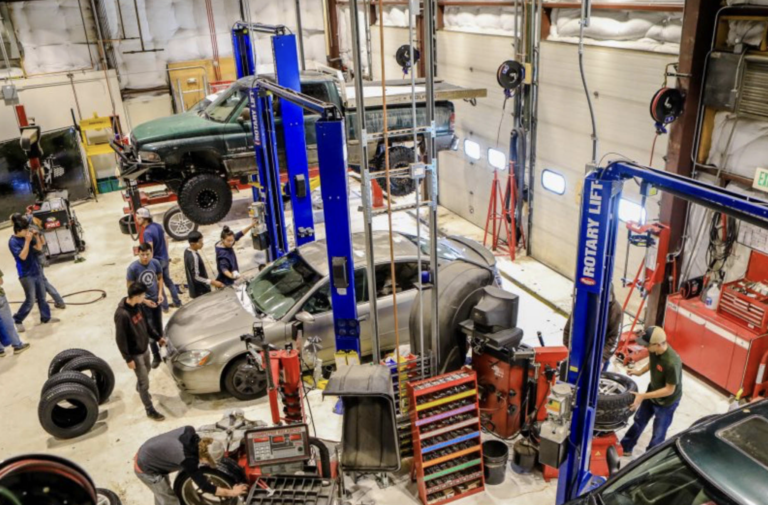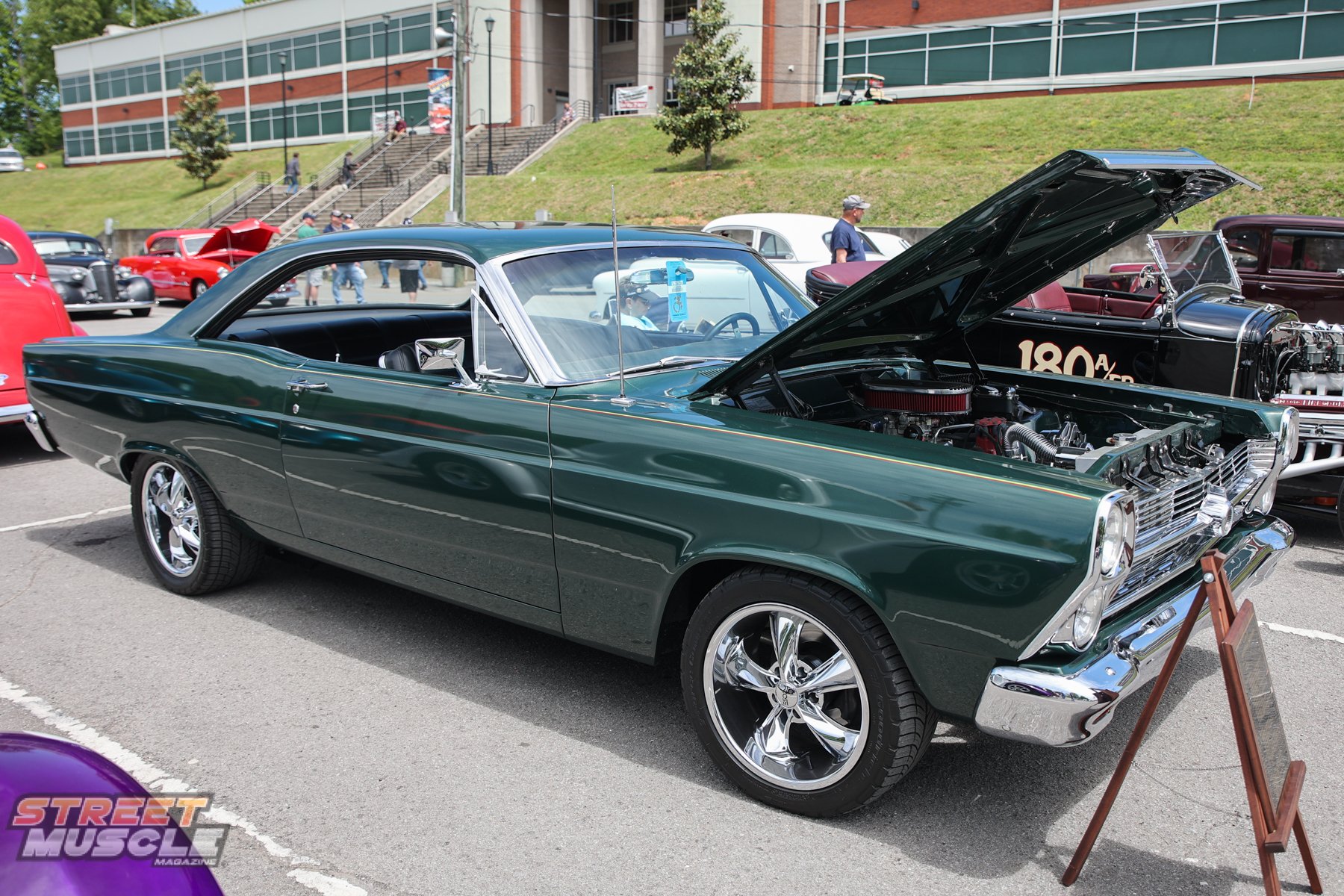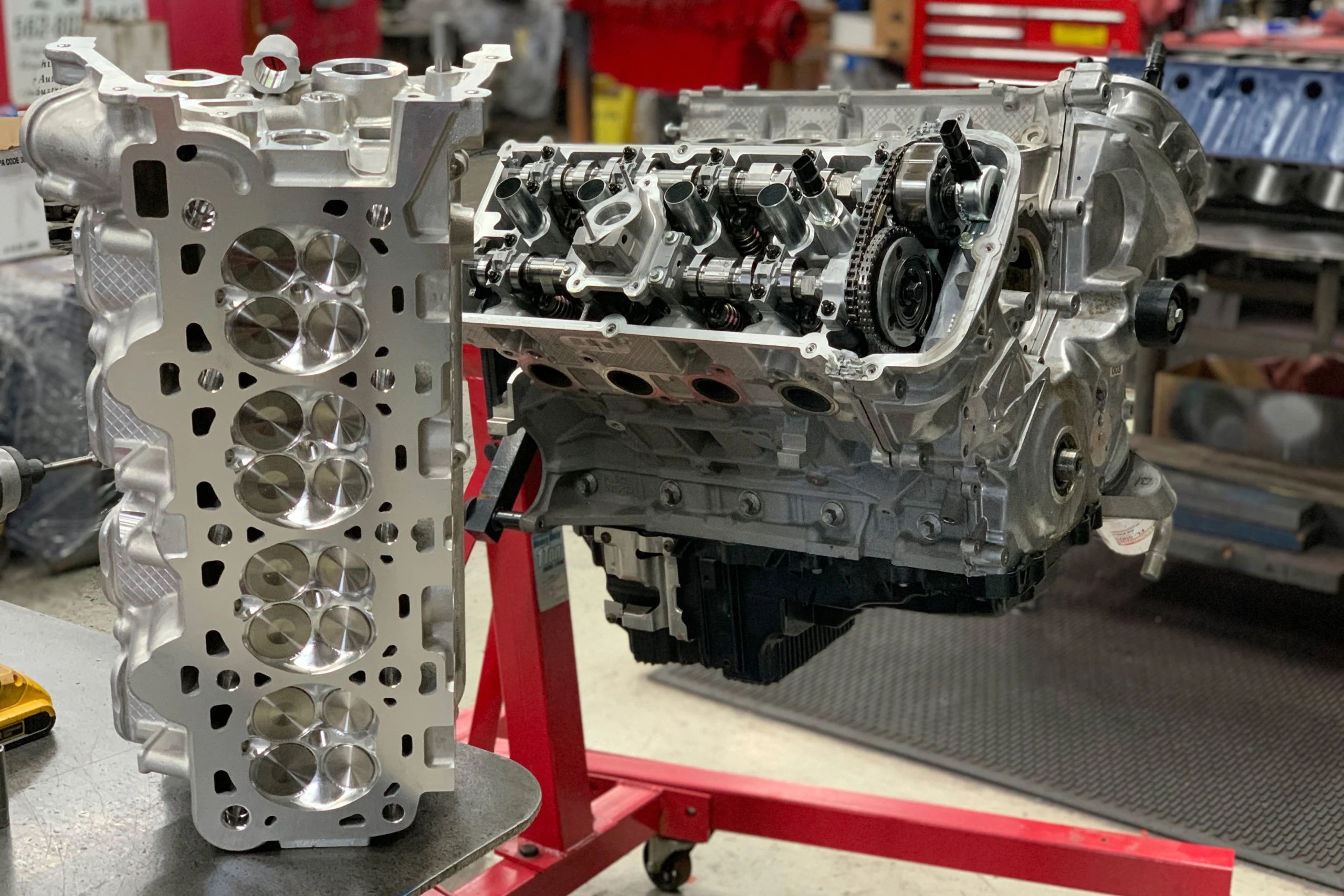The perfect driving experience and the melding of music and machines is what Cars and Guitars are all about. So buckle up, drop it into reverse, and floor it back a thousand years when the 1965 Mustang and Martha and the Vandellas ruled the earth.
If there’s one thing that pop culture has taught us, it’s that pop music and muscle cars go together like Blood Marys and asparagus spears. In the roaring 60s, with every breakthrough in car design, there was a commensurate musical benchmark wafting out over the radio airwaves.
“Nowhere To Run To,” by Detroit’s newly minted girl group Martha and the Vandellas, was such a game changer. The group exploded on the charts in the early 60s and cemented Motown founder Berry Gordy as one of the top hitmakers in the world. If there were ever a video clip perfect for a Cars and Guitars installment, it’s this promo film for “Nowhere To Run” inside the original Mustang factory in Dearborn, Michigan. Watch as the girls dance through the paint booth (nobody’s wearing masks) and prance around a moving assembly line full of embryonic Mustangs. A fantastic snapshot in time.
The Ford Mustang wasn’t just a car; it was a cultural phenomenon. Sleek, sexy, and affordable, it captured the sweet spot of youth and fashion of its day. The original Ponycar’s success wasn’t accidental. It was the combination of bullseye marketing, parts bin engineering, and a publicity blitz that changed the auto industry forever.
From Concept to Reality in Record Time
The Mustang’s story begins with Lee Iacocca, an ambitious Ford head honcho who envisioned a sporty car for baby boomers. He assembled a hotshot development team led by Donald Frey, an engineer known for his speed and efficiency. Frey and his team worked tirelessly, pulling all-nighters and pushing their limits to bring Iacocca’s vision to life. The result was the Mustang 1 two-seater roadster, ready in 18 months. For reference, 36-48 months was the average gestation period for a new car in the 60s.
Mustang I Concept
Refining the Design for Mass Appeal
The Mustang I was a head-turner, but Iacocca knew the two-seater configuration wouldn’t cut it with buyers. The two-seat Thunderbird taught Ford that lesson ten years earlier. So, the team went back to work, creating the Mustang II (not the 1974 model), a four-seater concept that would appeal to a broader audience. This iteration sported a modern rectilinear profile and retained the sporty essence of the Mustang 1, paving the way for the production model.
An Early Introduction and Magical Marketing
Ford execs could sense they had a winner on their hands, and they weren’t going to wait until September of 1964 to introduce the car, as was standard procedure back then. Instead, they unveiled the Mustang five months early, at the 1964 New York World’s Fair. This audacious move generated huge buzz, cleared the clutter of other new car intros, and generated favorable press in thousands of newspapers across the country the next day.
To continue the momentum, Ford capitalized on the public’s excitement with clever marketing campaigns. The Mustang’s $2,368 price tag (roughly equivalent to $21,990 today) made it accessible to a whole new generation of car buyers. Its variety of body styles – hardtop, convertible, and a new fastback for 1965 – offered something for everyone. Even Carrol Shelby got involved in the Mustang stampede offering a souped version with more horsepower and beefed-up suspension.
For 1965, the 260cid V8 was enlarged to 289cid and a six cyclinder gained displacement too. And then there was the magic of Hollywood. The Mustang’s cameo role in James Bond’s Goldfinger cemented its cool factor, forever etching a celluloid image of a Wimbledon White Mustang convertible, with a hot babe at the wheel, tearing through the Swiss Alps.
?si=s6dJVUqhyJjZlhd4
Surpassing All Expectations
Blue Oval execs originally projected sales of 100,000 units in the first year, but they hit that bogey in just three months. By the end of 1965, over 318,000 Mustangs had been sold, setting a new record. And within 18 months, the one-millionth Mustang rolled off the assembly line. Today, 50,000 Mustangs sold annually is considered a good year.

Lee Iacocca introduces the new 1965 Ford Mustang to the media in the Ford Pavilion at the 1964 World’s Fair in New York.
The early Ford Mustang’s success wasn’t just about numbers. It was about a cultural shift. It represented individuality, freedom, and a four-wheeled version of tank tops and bell bottoms. More than anything else, the Mustang was cool. It also appealed to almost everyone. From teenagers and secretaries to drag racers. It also caught arch-rival Chevrolet flat-footed and must have ruffled many feathers over at GM headquarters.
?si=ZHpgUlL_pvqzR-S6
Meanwhile in America
Almost sixty years ago, Lyndon Johnson was occupying 1600 Pennsylvania Avenue, a little more than a year after John F. Kennedy’s assasination. The war in Vietnam was reaching a boiling point, the space race was in full swing, the Rolling Stones were on a world tour, the Voting Rights Act was passed, and the Eero Sarrinen’s St. Louis Arch was completed. Malcolm X was assassinated, NASA’s Mariner 4 floated by Mars, race riots erupted in Watts, California, and Muhammad Ali defeated Sonny Liston.
Nowhere to Run To, Baby
Get in and fasten your seatbelts because “Nowhere to Run” was more than an average Motown recording session. This song was a sonic adventure cooked up by the legendary Funk Brothers band, and songwriters Holland-Dozier-Holland under the watchful eye of Motown impresario Berry Gordy. Gordy was influenced by Phil Specter’s “Wall of Sound” and you can hear similar arrangements in “Nowhere To Run To.”
Classic Girl Group
Reeves uses her voice as an instrument, bending it to every twist and turn of the music. The Vandellas weren’t just backing vocals, they were part of the “Call and Response” arrangement, and the three blend seamlessly. To capture the raw energy of a tune, Motown songs were recorded live, rather than overdubbing tracks later. This captured the musicians playing off each other, adding authenticity to the song’s groove.
The Original Members
The group was formed in Detroit in 1957 by three friends: Rosalind Ashford, Annette Beard, and Gloria Williams. They originally called themselves the Del-Phis and performed at local clubs and events. In 1960, they signed with Chess Records, but their singles failed to chart.
In 1961, they met Martha Reeves, a former member of two other groups, the Fascinations and the Sabre-Ettes. Reeves joined the Del-Phis as a backup singer but soon became the lead vocalist after Williams left the group. The group also changed their name to the Vels and auditioned for Motown Records.
At Motown, they caught the attention of producer William “Mickey” Stevenson, who hired Reeves as his secretary and the rest of the group as session singers. They also changed their name again, this time to Martha and the Vandellas, after Reeves’ favorite singer, Della Reese, and Van Dyke Street, a main thoroughfare in Detroit.
The Top Ten Hits
Martha and the Vandellas scored their first hit in 1963 with “Come and Get These Memories”, a song written by Holland-Dozier-Holland. The song hit number six on the Billboard R&B chart and 29 on the Billboard Hot 100.
The group’s breakthrough came later that year with “Heat Wave”, another Holland-Dozier-Holland composition. The song was a fiery dance tune that showcased Reeves’ powerful vocals and the group’s tight harmonies. It reached number one on the R&B chart and number four on the Hot 100, earning the group not only a Grammy nomination but they were the first black artists to be selected by the organization.
Martha and the Vandellas had hit after hit, such as “Quicksand” (1963), “Nowhere to Run” (1965), “I’m Ready for Love” (1966), and “Jimmy Mack” (1967). Their most famous and enduring song, however, was “Dancing in the Street” (1964), co-written by Stevenson, Marvin Gaye, and Ivy Jo Hunter. The song was a call to action and celebration, inviting people of all races and backgrounds to join in the music and dance. It was a global hit that reached number two on the R&B chart and number eight on the Hot 100 in North America.
The Legacy
Martha and the Vandellas disbanded in 1972 after Reeves left Motown to pursue a solo career. The group had undergone several personnel changes over the years, with Betty Kelly, Lois Reeves (Martha’s sister), and Sandra Tilley replacing Beard and Ashford at different points.
In 1995, Martha and the Vandellas were inducted into the Rock and Roll Hall of Fame, becoming the second Motown act and the third girl group to receive the honor. In 2013, they were also inducted into the National Rhythm & Blues Hall of Fame.
In 2025, the song “Nowhere To Run To” and the Mustang will celebrate their 60th anniversary. Not only do the Mustang and the Vandellas share 1965 as a momentous year, but all three women and the Mustang are alive and well in 2024. Martha Reeves was elected to the Detroit City Council and served from 2005-2009. She continues to perform at 83 years old.
The Mustang is the last pony car in the world (for now) as the Dodge Challenger and Chevy Camaro went the way of the do-do in 2023. As always, queue up your music service to Martha and the Vandellas and rewind to the golden era of rock and R&B. Just find a nice stretch of tarmac, crank it up, and relive the sweet combination of Mustang and Motown.
See you next time.































